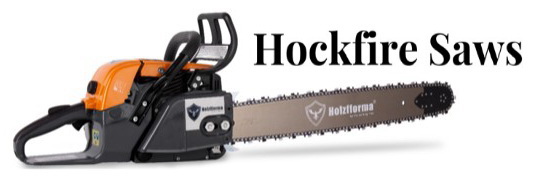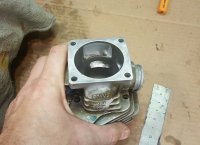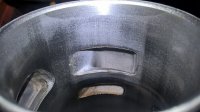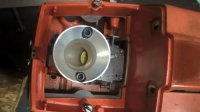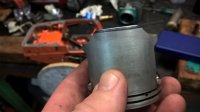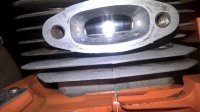Took my 2100 from 70/122/108 to 75/122/105
I have kept the exhaust low cause I want low RPM torque for milling.
Its been fitted with a 288 plastic filter neck and V-Stack.... K&N in the mail
Trimmed the piston skirt to increase intake duration so I can still fit a 395 piston down the track if needed.
I also took the square edge off the bottom of the lowers. Instead of a sharp 90* edge its now a smooth rounded edge which should help flow without changing the overall character of the saw.
Lowers before smoothing out..... very square. I only lowered them 2 or 3 mm by rounding but I think it will gain a lot of flow.
View attachment 27681
The plastic 288 neck is much larger than the stock metal one
View attachment 27682
Black mark is how much I removed from the intake piston skirt to lower the intake.
View attachment 27683
Exhaust port raised a few degrees, widened 3mm each side and belled a bit after I lowered the squish to .035 with a thin gasket.
View attachment 27684
Reading the talk on torque a few pages before the photo upload scandal derailed it got me thinking about the Husky 2100.
It is famous for its stump melting torque yes?
Mine has the original KS piston and cylinder and measured 70/121/106 with .055 to .056 squish.
I know general consensus on this was it would make more power with a higher exhaust, but I have been thinking why this saw is so famous for torque with such a low exhaust?
With the hardness of timber here in Australia, and my experience thus far doing as is done in the USA, all I end up with is a saw running at a higher RPM that cuts slower because the wood is too darn hard for the chain to bite and self feed into at the higher chain speed.
I put a 8 pin on my 066 with a 20" and it should do it easy but I have to force it into the wood. It actually self feeds into the timber better with a 7 pin which lets the teeth dig into the timber V's skipping over it. the wood is just too hard here.
So the statement that RPM is king is not always entirely true. In the rock hard wood I cut it just results in less chips/more dust and more chain stretch.
I want a saw with RPM down lower in the rev range. Chain speed is detrimental in what we call hardwood.
Stuff like spotty gum that we consider soft is actually 1.5 times harder than oak.
Im not saying we are better or starting a wood war..... more trying to point out that what works in one situation will not work in another.
I watch Jay's video's and want to replicate, but it wont work here simple as that.
I need a saw that will run at lower RPM and make big torque to be able to handle being dogged into timber hard enough to stretch 404 chain to the point of jumping off in less than a tank of fuel if I push it too hard.
Dave said in a post that faster the chain spins, faster it cuts. (not a quote Dave

)
It will only work if the wood is soft enough to allow the teeth to dig in enough to remove full raker depth chips. In my experience with Australian hardwood, faster chain speed just makes more dust and I need to force it in. When it bites it does cut fast but drags down speed and stretches the chain big time.
So, what interests me, and probably others in Oz, is what will boost torque down low where we spend more time when cutting?
I see saws ported in the USA to suit and cut the fastest in the timber you have, but I can tell you right now that massive chain speed with square filed chain wont work in ironbark for long.
I guess asking here is not the best place because you guys in the states are not going to develop saws to cut nasty hard timber.
I would be interested in your thoughts on what may work though.
I am thinking more exhaust and low blow down?






